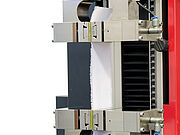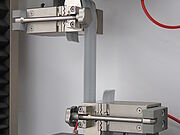Testing on Textile Fabrics; Coated Textiles and Geotextiles
The tests carried out on textile fabrics are just as varied as the uses found for their finished products. Depending on test requirements, specimens are tested in a wet or dry state, having been removed parallel to the warp and weft directions of the fabric.
ZwickRoell offers ideal solutions for these types of tests: testing machines of various designs, suitable specimen grips and corresponding jaw inserts as well as the proven testXpert testing software for every application.
Tensile Tests on Textile Fabrics to DIN EN ISO 13934-1
In tests according to DIN EN ISO 13934-1, 50 mm-wide strip specimens are tested both in a standard atmosphere and in a wet condition, once in the warp and once in the weft direction.
Pneumatic grips are preferred due to the surface properties of the most commonly used types of fabric. This standard requires determination of maximum force and (measured via crosshead travel) elongation at maximum force. Elongation at maximum tensile force is measured via the crosshead travel.
The test method described here mainly applies to woven textiles, but can also be applied to other fabrics. It is usually not applicable to elastic woven fabrics, geotextiles, nonwovens, coated fabrics, glass fiber fabrics and textile fabrics made of carbon fibers or polyolefin fiber yarns.
Specimen removal takes place either as stipulated in the material specification for the textile fabric or as agreed between the interested parties. The test samples must have no creases, folds, selvedge or areas that are not representative of the fabric.
An optical extension measuring system can be used for higher measurement accuracy without clamping influence. A mechanical measuring system should be used only when the risk of damage at specimen break does not exist.
If jaw breakage or slippage cannot be prevented with flat clamping jaws, deflection grips have proven to the right option. Elongation measurement must be carried out with an optical extension measuring system because the crosshead travel reference value for the strain cannot be precisely defined.
Tear Resistance on Textiles to EN ISO 13937-2 and EN ISO 9073-4
Specially cut specimens are used for the tear growth test. Tests according to EN ISO 9073-4 are carried out on trapezoid specimens, whereby the use of very wide jaws should be noted. Pneumatic grips are preferred because they offer even and subsequent adjustment of the gripping.
Tests according to DIN EN ISO 13937-2, the so-called trouser tear test, use test specimens cut to resemble a pair of trouser legs. The document describes the tear force test of trouser-shaped specimens, in which a specimen is cut to resemble a pair of trouser legs. The joint tear propagation force is the force required to tear this incision further when the force is applied parallel to the incision and the textile fabric tears in the direction of the force. In this case, the use of pneumatic grips is recommended.
Testing to Marks & Spencer
One important quality characteristic in processing textile fabrics is seam slippage resistance.
The example here concerns the support developed by Marks & Spencer P12 for testing the seam slippage resistance of clothing fabrics. This standard defines the determination of the resistance of the thread systems in a clothing fabric to displacement in the vicinity of the seam, as caused by the sewing yarns.
The 75 mm wide fabric specimens are held in pneumatic grips and the force is measured when the seam separates by a defined distance. The force-travel diagrams of a seamed and a seamless reference test specimen of the same material are then compared.
Marks & Spencer tests are precisely defined and must not be modified. We are authorized suppliers of testing equipment for the following Marks & Spencer tests:
P11, P12, P12A, P12B, P13, P13A, P14, P14A, P15 Part 1 and P15A
Tensile Tests on Geo-Fabrics and Non-Woven Geotextiles to EN ISO 10319
Tensile test on nonwoven geotextiles with optical long-travel measuring system, using pneumatic grips according to DIN EN ISO 10319. The main feature of this method of determining the tensile strength of fabrics is the width of the specimen.
For the basic test, the specimen width (200mm) is greater than the length (100mm), as some geotextiles have a tendency to contract, or "neck down", at an angle to the force direction under tensile loading. The extra width reduces the "neck down" effect, providing a relationship closer to expected product behavior in this area.
An optical travel measuring system is used because large amounts of energy can be released at break. A mechanical measuring system should be used only when the risk of damage at specimen break does not exist.
Alternatively, a hydraulic grip must be used for high forces.
Static Puncture Test (CBR Test) to DIN EN ISO 12236
DIN EN ISO 12236 describes a method for determining the puncture resistance of geotextiles and related products. The force arising when a flat-ended plunger is pushed through the test specimen is measured. The specimen is clamped between two steel rings via hydraulic end clamping.
The test is usually carried out with dry test samples that have been conditioned in the defined climate. The test is applicable to most types of products, but not to materials with openings larger than 10 mm.
Tensile Tests on Textile Glass Fabric to ISO 4606
In this example tests are carried out on textile glass fabric. The international standard specifies the method for determining the force at break and elongation at break of frayed strips of woven textile glass. This method is used for untreated glass fabrics or glass fabrics treated with reinforcement materials, however not for glass fabrics coated with plastics or elastomers.
In accordance with ISO 4606, 50mm-wide strips are here being tested up to failure in both the warp and weft directions. A clamping length of 200 mm is used. Since high gripping forces are required to hold the specimen in compliance with standards, pneumatic specimen grips are used. Specimens used for testing must display no folds or creases, selvages or areas which are not representative of the fabric.












